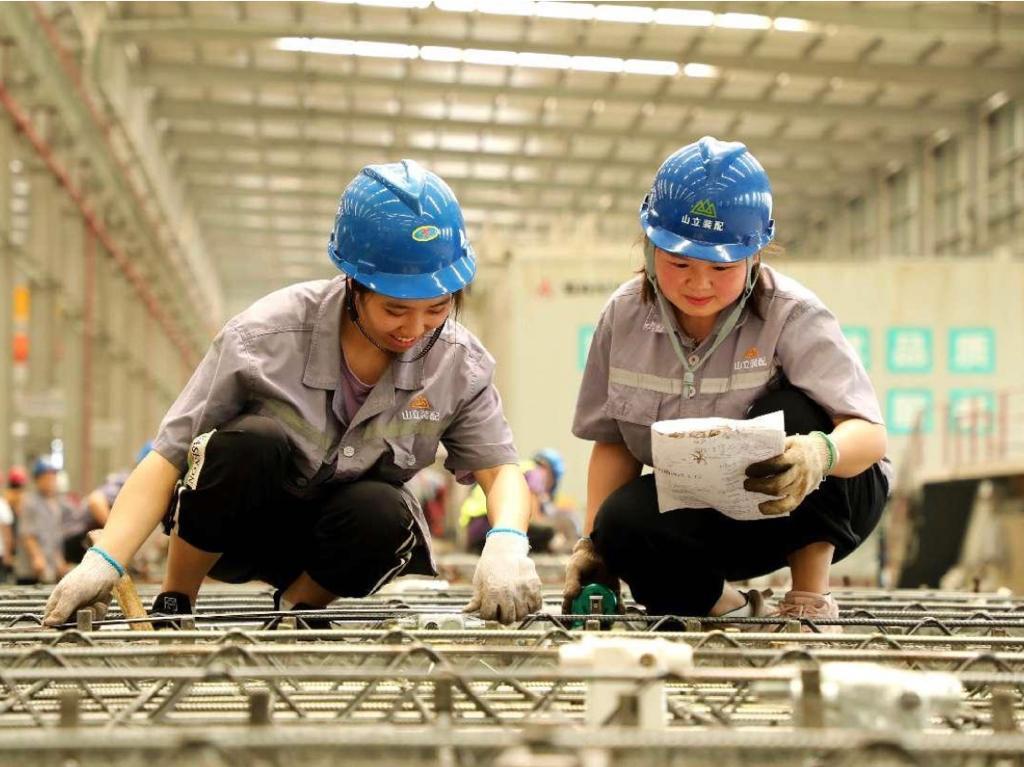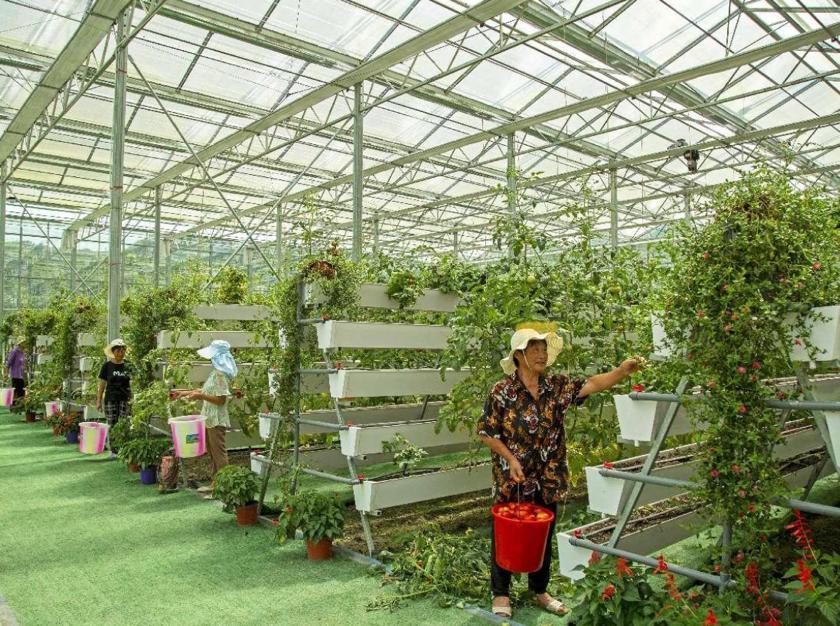News
China sees bright prospects in green development

China sees bright prospects in green development
By: Yin Shuanghong
China’s first prefabricated high-rise vertical factory, the phase-1 project of the Pingshan New Energy Vehicle Industry Park in Shenzhen, south China’s Guangdong province, was completed and delivered in April this year.
Thanks to the application of smart technologies, the construction period of the factory was saved by 15 percent, water and electricity usage by 20 percent, and waste discharge by 20 percent.
The high-rise vertical factory enables intensive land use and is conducive to resource recycling in the industrial park. It is an epitome of the green development of the manufacturing sector.
Promoting green and low-carbon economic and social development is a key part of achieving high-quality development. In recent years, China has made significant progress in fostering new growth points for green and low-carbon development.
In the manufacturing sector, the production of solar cells and charging piles increased by 63.2 percent and 34.2 percent respectively in the first three quarters of this year, while the production and sales of new energy vehicles grew by over 30 percent year-on-year.
In the energy industry, as of the end of September, the installed capacity of solar power generation increased by 45.3 percent compared to the previous year, and wind power installed capacity by 15.1 percent.

Green technologies and products continue to emerge in various sectors and industries, effectively promoting the optimization of industrial structure and demonstrating a strong momentum for industrial upgrading.
As a new driving force, the growth of the green industry can create a broader space for economic development. Green, circular, and low-carbon development is the direction of today’s technological revolution and industrial transformation, and the most promising field for development. A better grasp of the opportunities for green transformation can take the initiative and gain a favorable position in future competition.
According to data from the General Administration of Customs, the total exports of electric vehicles, lithium-ion batteries, and solar batteries reached 798.99 billion yuan ($109.83 billion) in the first three quarters this year, a year-on-year increase of 41.7 percent. China’s leapfrog development in green industries fully demonstrates the importance of pursuing sustainable economic growth.
Green development is sustainable. Only by laying a solid foundation for green development can China achieve high-quality development in the future. China has great potential in this regard and can build a number of growth points.
Currently, the country is actively promoting concerted efforts to cut carbon emissions, reduce pollution, expand green development, and pursue economic growth. It prioritizes green transformation and upgrading of industries, accelerates the cultivation and expansion of green and low-carbon sectors, actively develops green technologies and products, and makes the economy greener, so as to enhance the potential and momentum of development.
China’s renewable energy industry is developing rapidly, and the country leads in various fields such as energy equipment, water-saving equipment, and pollution control technologies.
New ecological industry models, including urban modern agriculture, eco-tourism, and rural complexes are also rapidly growing. Today, eco-friendly products have more ways for financial gain.
It is believed that as China continues to pursue green development, the Chinese economy will become even greener in the future.
Green development is an all-round and revolutionary transformation of production methods, lifestyles, ways of thinking, and values. To promote the growth of green industries, it is necessary to adhere to a systemic perspective and coordinate the greening of production, distribution, consumption, and other aspects. It is important to actively guide and mobilize the entire society to participate in green development. With the continuous advancement of Chinese modernization and the improvement of people’s living standards, the concept of green development has permeated all aspects of Chinese people’s lives.
The demand for green upgrading and transformation of traditional industries, as well as the demand for green consumption, have given rise to a huge green market, continuously enhancing China’s development potential and momentum.
By further opening up new areas and creating new advantages, China is striving to promote economic development that not only maintains reasonable quantitative growth but also achieves steady qualitative improvement, allowing the people to have a greater sense of achievement, fulfillment, and security in a beautiful ecological environment.
China sees bright prospects in green development
News
NHRC Calls for Reforms in Correctional Centres, Cites Systemic Bias

NHRC Calls for Reforms in Correctional Centres, Cites Systemic Bias
By: Michael Mike
The Executive Secretary of the National Human Rights Commission (NHRC), Dr. Tony Ojukwu has called on stakeholders to reflect on the values that Nelson Mandela embodied, including justice, dignity, equality, and compassion, as the world commemorates World Mandela Day.
Dr. Ojukwu made this call in a statement on the eve of the commemoration, noting that Mandela’s legacy serves as a powerful reminder of the need to promote and protect human rights, particularly in Nigeria’s correctional centers.
According to him, the current state of Nigeria’s correctional centres, which are overcrowded, under-resourced, and lack basic sanitation and healthcare, reflects a failure of infrastructure, justice, and humanity.
He lamented that thousands of citizens are held in pre-trial detention for years due to poverty and lack of access to justice, while the rich have greater access to quality legal defense and bail, perpetuating systemic bias.
The NHRC Executive Secretary urged the Nigerian government, judicial authorities, private sector, and civil society to prioritize comprehensive reforms in detention facilities and correctional centers, including improving conditions, investing in alternatives to pre-trial detention, ensuring speedy trials, and upholding the rights of inmates.
Ojukwu emphasized the need to tackle the root causes of incarceration, such as poverty, unemployment, and lack of access to justice, in order to build a society that values the dignity and human rights of all individuals, regardless of their socio-economic status.
Nelson Mandela Day is celebrated annually on the 18th of July.
NHRC Calls for Reforms in Correctional Centres, Cites Systemic Bias
News
Ondo State Government Signs MOU with Backbone Infrastructure for 500,000 BPD Oil Refinery

Ondo State Government Signs MOU with Backbone Infrastructure for 500,000 BPD Oil Refinery
By: Michael Mike
The Ondo State Government has signed a Memorandum of Understanding (MOU) with Backbone Infrastructure Limited for the establishment of a 500,000 barrels per day oil refinery and development of free trade zone in Igbotiri, Ilaje Local Government Area of the state.
The signing ceremony took place at the Governor’s office in Akure.
The Secretary to the State Government, Dr. Taiwo Fasoranti represented the Governor, Dr. Lucky Aiyedatiwa at the ceremony.
He described the proposed investment as timely and strategic, assuring the investors of a peaceful and business-friendly environment.
He emphasized that the project would boost the state’s economy, create meaningful job opportunities, and reduce crime.
In his remarks on behalf of Backbone Infrastructure, the Vice President, Legal & Corporate services, Barrister Wale Adekola expressed appreciation to the Ondo State Government for the opportunity to partner in the infrastructure development of the State and assured of his company’s commitment to ensure successful delivery of the two projects.
Similarly, the Managing Director / Chief Executive of Backbone Infrastructure Nigeria Limited, Engr. Henry Owonka, revealed that the two projects would be accompanied by basic infrastructure such as roads, terminal storage tanks, and other facilities that will change the landscape of the State.
According to the MOU breakdown on the Refinery, Backbone Infrastructure Limited will hold 65% equity, while the Ondo State Government will hold 20% and the Nigerian National Petroleum Corporation Limited (NNPCL) will hold 15% stake.
Meanwhile, the investors have expressed confidence in the leadership and vision of the Aiyedatiwa-led administration, citing the clarity of purpose and support they have received as the reason for choosing Ondo State as their investment destination.
The state government equally pledged its support for the project, which is expected to transform the state’s economy and create jobs.
Present at the signing of the MOU were the Secretary to the State Government, Dr. Taiwo Fasoranti. Attorney General and commissioner for Justice, Kayode Ajulo, SAN , the ONDIPA Team while the Backbone team was led by Dr. Steve Dike, a member of the Board of Directors representing the Chairman, Senator Ken Nnamani, Managing Director/CEO Engr. Henry Owonka, the Vice President, Legal & Corporate Services, other members of the management team from the Backbone infrastructure limited among other top government functionaries.
Ondo State Government Signs MOU with Backbone Infrastructure for 500,000 BPD Oil Refinery
News
Police arrest notorious gunrunners in Benue, recover rocket launcher, AK-47 rifles, thousands of ammunition

Police arrest notorious gunrunners in Benue, recover rocket launcher, AK-47 rifles, thousands of ammunition
By: Zagazola Makama
Operatives of the Force Intelligence Department–Intelligence Response Team (FID–IRT) have arrested two notorious arms traffickers and recovered a cache of deadly weapons in Abinsi town, Guma Local Government Area of Benue State.
Sources from the Benue State Police Command confirmed the development Thursday, describing the arrest as a major breakthrough in ongoing efforts to curb the proliferation of illegal arms fueling insecurity in the North-Central region.
According to the sources, the suspects led by one Adikwu Ikwulono, a known illegal arms dealer were apprehended on Wednesday following credible intelligence.
Recovered from the suspects were one rocket launcher, five AK-47 rifles, and thousands of rounds of 7.62mm live ammunition.
Police say preliminary investigations revealed that the arms were being assembled for delivery to a gang of armed herders and bandits operating around the Benue–Nasarawa border, with plans to launch coordinated attacks on several communities in Benue State.
“The suspects are currently undergoing intensive interrogation with the FID, while efforts are ongoing to apprehend other members of the arms-smuggling syndicate,” the police sources said.
Police arrest notorious gunrunners in Benue, recover rocket launcher, AK-47 rifles, thousands of ammunition
-

 News1 year ago
News1 year agoRoger Federer’s Shock as DNA Results Reveal Myla and Charlene Are Not His Biological Children
-

 Opinions3 years ago
Opinions3 years agoTHE PLIGHT OF FARIDA
-

 Opinions4 years ago
Opinions4 years agoPOLICE CHARGE ROOMS, A MINTING PRESS
-

 News1 year ago
News1 year agoEYN: Rev. Billi, Distortion of History, and The Living Tamarind Tree
-

 Columns1 year ago
Columns1 year agoArmy University Biu: There is certain interest, but certainly not from Borno.
-

 ACADEMICS1 year ago
ACADEMICS1 year agoA History of Biu” (2015) and The Lingering Bura-Pabir Question (1)
-

 Opinions1 year ago
Opinions1 year agoTinubu,Shettima: The epidemic of economic, insecurity in Nigeria
-

 Politics1 month ago
Politics1 month ago2027: Why Hon. Midala Balami Must Go, as Youths in Hawul and Asikira/Uba Federal Constituency Reject ₦500,000 as Sallah Gift





